by Niki Crawson | Aug 27, 2024
 When you think of the word “crafting,” you may think of hot glue sticks and pipe cleaners, but crafting also includes practices such as ceramics, woodworking, calligraphy, and leather stamping as well. Using crafting as a teaching tool can encourage youth to apply problem-solving skills, develop new interests, and increase confidence, all while having a fun, hands-on experience. This post covers how crafting can support the 4-H project, what crafting is, and how to prepare craft exhibits for the fair.
When you think of the word “crafting,” you may think of hot glue sticks and pipe cleaners, but crafting also includes practices such as ceramics, woodworking, calligraphy, and leather stamping as well. Using crafting as a teaching tool can encourage youth to apply problem-solving skills, develop new interests, and increase confidence, all while having a fun, hands-on experience. This post covers how crafting can support the 4-H project, what crafting is, and how to prepare craft exhibits for the fair.
Does Crafting Support the 4-H Project?
YES! Exhibiting project work in 4-H is a cornerstone of the program’s philosophy of “learning by doing.” It provides young members with the opportunity to showcase their hard-earned skills, creativity, and dedication to a wider audience. Whether it’s raising livestock, crafting, or coding, exhibiting project work is about more than just winning ribbons—it’s about developing life skills, personal growth, and building a foundation for lifelong learning. There are several benefits to exhibiting project work, which is why it is one of the components of completing a 4-H project:
- Recognition and Achievement: When 4-H members exhibit their work, they receive recognition for their efforts. This acknowledgment, whether through awards, feedback, or simply having their work on display, boosts self-esteem and motivates them to continue learning and improving. The process of preparing for an exhibition teaches members to set goals, meet deadlines, and take pride in their accomplishments.
- Learning and Improvement: Exhibiting allows 4-H members to receive constructive feedback from judges and peers. This feedback is invaluable for growth, helping them identify areas for improvement and encouraging them to refine their skills. It’s an integral part of the learning process, fostering a mindset of continuous improvement.
- Communication Skills: Presenting a project to an audience or judge develops critical communication skills. Members learn to explain their work, articulate their ideas, and answer questions. This experience is crucial for building confidence and public speaking abilities, which are essential life skills.
- Community Engagement: Exhibiting projects at fairs or community events connects 4-H members with their local community. It’s an opportunity to share knowledge, inspire others, and demonstrate the positive impact of 4-H. Exhibitions also highlight the diversity of interests and talents within the program, showcasing the broad range of opportunities 4-H offers.
- Encouraging Responsibility and Work Ethic: Preparing a project for exhibition requires planning, attention to detail, and perseverance. Members learn to take responsibility for their work, from the initial idea through to the final presentation. This process instills a strong work ethic and prepares them for future challenges in education and careers.
Benefits of Incorporating Crafting into Project Work
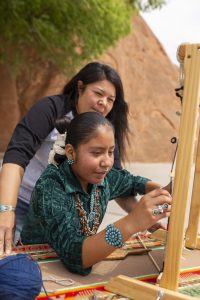
Crafting can be a great way to learn about different cultures!
Crafting can significantly support the 4-H Project by providing hands-on learning opportunities that align with the program’s focus on developing practical skills, creativity, and problem-solving abilities. Here’s how crafting can contribute to 4-H projects:
1. Skill Development
- Practical Skills: Crafting teaches valuable skills such as sewing, woodworking, painting, and other forms of art. These skills can be directly applied to various 4-H projects, from home economics to environmental stewardship.
- Fine Motor Skills: Activities like knitting, embroidery, and model building improve hand-eye coordination and dexterity, which are beneficial in many 4-H activities.
2. Creativity and Innovation
- Project Personalization: Crafting allows members to personalize their 4-H projects, making them unique. For example, a 4-H member working on a gardening project might create decorative planters or garden markers.
- Problem-Solving: Crafting often involves figuring out how to create something from raw materials, which enhances problem-solving skills—a key component of many 4-H projects.
3. Educational Integration
- STEAM Learning: Craft projects can integrate science, technology, engineering, arts, and mathematics (STEAM). For instance, a project on building a birdhouse can involve measuring, cutting, and assembling, all while learning about bird habitats.
- Life Skills: Crafting teaches patience, attention to detail, and perseverance, which are important life skills that 4-H aims to instill in its members.
4. Community Service
- Donations and Fundraisers: Crafts can be used to create items for community service projects, such as blankets for shelters, or for fundraising efforts to support 4-H activities.
- Collaborative Projects: Crafting can be a group activity, fostering teamwork and collaboration among 4-H members.
5. Exhibition and Recognition
- Fair and Competitions: Many 4-H members exhibit their crafted projects at county or state fairs, earning recognition and awards. This provides a sense of accomplishment and encourages further learning and improvement.
- Portfolio Building: Craft projects can be included in a member’s 4-H portfolio, showcasing their skills and creativity, which can be beneficial for scholarships and future opportunities.
6. Personal Expression and Confidence Building
- Self-Expression: Crafting allows 4-H members to express their individuality and creativity, which can boost self-confidence and a sense of ownership in their work.
- Presentation Skills: When presenting their crafted projects, members develop communication and presentation skills, important aspects of 4-H education.
7. Sustainability and Environmental Awareness
- Upcycling and Recycling: Crafting with recycled materials promotes environmental stewardship, a core value in 4-H. Members can learn to repurpose items, reducing waste and promoting sustainability.
- Nature Crafts: Projects that involve using natural materials, such as creating leaf prints or pinecone decorations, help members connect with the environment and understand the importance of natural resources.
8. Mental and Emotional Well-being
- Stress Relief: Crafting is a therapeutic activity that can reduce stress and promote mental well-being, helping 4-H members maintain a balanced lifestyle.
- Sense of Achievement: Completing a craft project gives members a sense of achievement, which is important for building self-esteem and a positive outlook.
Incorporating crafting into 4-H projects not only enhances the learning experience but also aligns with the program’s mission to empower youth to lead for themselves and their communities. Crafting has been a vital part of world culture and is still celebrated today. Pottery, woodworking, string art, and various other crafts have contributed to the documentation and passing down of history across generations. While crafting has adapted and changed over time, its importance is still the same. It provides artists with a means to express their passion and emotions through their creations, fostering appreciation and sharing among others. Moreover, the skills acquired from crafting seamlessly transition into practical workforce abilities used in daily life.
Examples of Crafting:
While crafting can cover many creative areas, here are a few examples that you can introduce to youth that may spark their interest. This infographic can also be a helpful reminder!
- Paper Goods– calligraphy, paper dyeing, origami, decoupage, scrapbooking
This is a great starter project for youth of any age and make great gifts for everyone. Crafts such as cardmaking and origami can help introduce youth to using hand-eye coordination. This project is cost-effect as it can be made with a variety of supplies, including paper, markers, stamps, leaves, flowers, magazine clippings and more. Consider having a messy craft when the project is introduced so that youth can get comfortable with thinking outside of the box and brainstorming ideas based on the supplies provided.
- Home Goods– candles, ceramic pottery, macramé, wreaths, stained glass
For youth who may be interested in creating items they can give as gifts or make a profit from, crafting home goods is a great option. This type of project requires a few extra supplies but can be a rewarding experience. Some crafts such as stained glass and ceramics can become expensive, so you will want to make sure you have the right audience before investing. Since these crafts can vary in difficulty, size, and style, it can be a fun place to start with youth that may be new to crafting entirely. Macramé, making beeswax sheet candles, or clay figurines may be a good place to start to help spark interest.
Note that things like needlework, woodworking, sculpture, and jewelry belong in other fair categories, and are not exhibited in Class 7 at the North Florida Fair
Preparing Your Craft Exhibit for the Fair
Now that you have learned more about crafting, how can you encourage youth to participate? It is important to remind youth that they can enter their goods into the fair and win premium money! For the North Florida Fair, Crafting is Class 7 and includes the following entries: macramé, ceramics, pottery, candles, wreaths, picture frames, holiday ornaments, etc. To exhibit your crafts, you will need to complete a fair 4-H entry form and submit it to your local UF/ IFAS County Extension Office by October 1st. Your local office will provide tags for your craft exhibits and submit your form to the fair office. Use this checklist to prepare your exhibits for the fair. You may also want to refer to the judges’ rubric; craft exhibits will be judged based on creativity, technique, and neatness.
Use this information to complete your entry tag for each item: When filling our your exhibit tag, be sure to write the red tag number on your Fair Entry Form. Here is the information you need to correctly complete your entry tag:
Here is the information you need to correctly complete your entry tag:
- Section – 210
- Class- 7
- Lot- This will be your age division; write “A” for juniors (8-10 years old), “B” for intermediates (11-13 years old), or “C” for seniors (14-18 years old).
- Exhibit- a short description of the item you are entering (example: horse holiday ornament )
- Exhibitor- Your name
- Address- Name of your county
Crafting is a fun and worthwhile way to learn new skills. Through crafting, youth learn new techniques and have fun and can share their crafts with others, which is all a part of the 4-H experience. And remember, if you need , 4-H has a great partnership with Joann Fabric and Craft Stores to support youth in their crafts through the Joann 4-H Rewards program.
For information on how to incorporate crafting into your program, contact your local UF/ IFAS County Extension Office to learn more or follow us on Facebook.
Resources:
North Florida Fair 4-H Club Department 210 Rules
4-H Entry Form (for non-animal exhibits such as crafts)
Class 7 (Crafts) Judges’ Scoring Rubric
Crafting Infographic
Example of how to fill out an Exhibitor’s Tag for the North Florida Fair Class 7 (Crafts)
Joann Fabric & Crafts (National 4-H Corporate Sponsor)
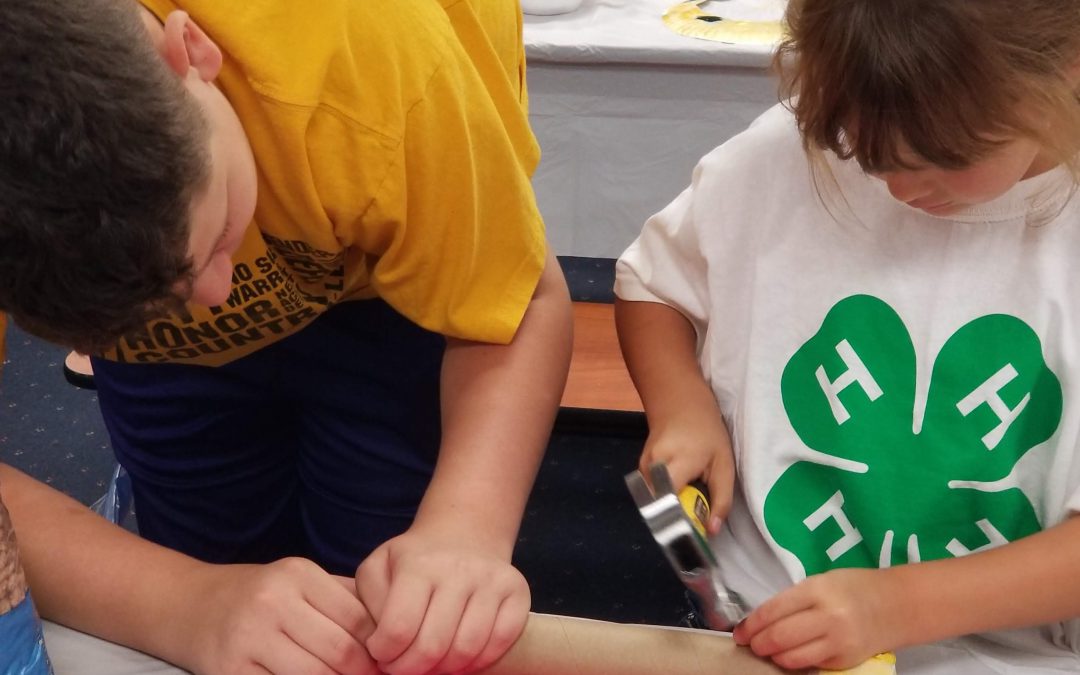
by Niki Crawson | May 19, 2023
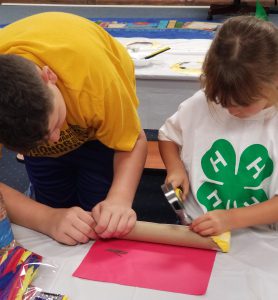
We know that younger youth look up to older youth and like to model their behaviors. We see it in siblings all the time, absorbing behaviors of their older brothers or sisters like sponges. Often times, younger youth find the attention and encouragement of older youth more relatable due to the closeness in age. Peer teaching fosters a more engaging and even symbiotic learning experience as this gives teens the opportunity to share and reinforce their own knowledge. In addition, by pairing the two age groups together in a learning environment, a sense of comradery can develop, creating a greater sense of belonging within the 4-H community. In this post, we will define peer teaching, share a few examples of how to utilize your teens as teachers and provide tips for getting peer teaching started in your clubs and other 4-H events and activities successfully.

WHAT IS PEER TEACHING?
What do we mean by peer teaching exactly? It is the process of youth learning together and from each other through engaging, hands-on activities. In 4-H, we have the wonderful ability to utilize teens as volunteers and positive role models for our younger youth in our positive youth development programs. Empowering our teens as teachers for our younger members allows life skills to develop among our youth being instructed and also the instructors. The teen instructors are teaching specific topics to their peers at the same time they are strengthening their own leadership, communication, and social skills.
WHAT ARE THE BENEFITS OF PEER TEACHING?
As stated previously, one of the greatest outcomes is that the teacher and the student both gain knowledge and skills. It creates a mutually beneficial environment in which all youth can achieve personal growth and development if implemented and managed correctly. In addition, there are many other benefits of peer teaching such as:
- Peers being taught may form a quicker and better connection with teens due to communication, technology and other trends.
- An increase in peer confidence as they may feel more comfortable in asking questions, discussing topics with others closer to their age.
- Greater creativity as teens may have more innovative or modern ideas to bring to the activities.
- An increase in volunteers as teens have the ability to recruit more teens easier than typical adult volunteers.
- An increase in retention of youth as peers stay in the program and become the next generation of teen volunteers/teachers.
WHAT DOES PEER TEACHING LOOK LIKE IN 4-H?
Below are just a few programs for teens to practice the method of peer teaching in their 4-H county:
- New Members – When new youth join 4-H, it can be overwhelming at times to learn some of the 4-H activities, customs, and such. This would be a great opportunity for
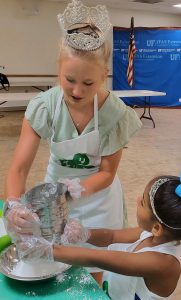 peer teaching. Have teens assigned to new members that join in order to teach them the 4-H pledge, motto, club expectations, member names, etc. This creates a greater sense of belonging and fosters a supportive environment within the club for new members to engage more quickly and successfully.
peer teaching. Have teens assigned to new members that join in order to teach them the 4-H pledge, motto, club expectations, member names, etc. This creates a greater sense of belonging and fosters a supportive environment within the club for new members to engage more quickly and successfully.
- Cloverbud Club Meetings – Utilizing your teen members in club meetings involving Cloverbuds (members ages 5-7) is a great way to incorporate peer teaching in your 4-H program. Younger members thrive off of creativity and enthusiasm which teens often portray easily. Teens can funnel this energy into teaching lessons to Cloverbuds that are engaging and interactive in a simplistic way.
- Summer Day Camps – 4-H programs often times need additional volunteers during the summer to assist with the volume of programming and youth participants. Therefore, summer is a great time to recruit teens to become peer teachers. Having teens as peer teachers helps with supervision and instruction while at the same time, allows them to stay involved in 4-H, continue to apply their life skills learned, and help the program teach life skills to other youth in the community.
TIPS TO GET PEER TEACHING STARTED IN YOUR 4-H COUNTY
What does it take to get peer teaching started in your 4-H county? Time and patience to start with. Teaching with teens is an ongoing task and will take a little effort on your part. Below are a few tips to get you started on having teens peer teach in your county:
- Identify programming that would benefit by peer teaching.
- Recruit quality teen teachers.
- Train and support teens as peer teachers.
- Assign teens appropriate roles in the peer teacher process.
- Model appropriate teaching methods in 4-H programs.
- Shadow teens in the role as peer teachers to provide support and guidance.
- Evaluate, provide feedback, and continue professional development for continued success.
Remember, peer teaching is a great way to utilize teen members in your 4-H programs. Younger youth need as many positive role models as possible in their lives. By having teen teachers take the lead in instruction in your 4-H programs, you are fostering an environment of learning, inclusivity, empowerment, and leadership.
To learn more about 4-H opportunities where teens can take the lead as teachers for their peers, please contact your local UF IFAS County Extension Office, or visit http://florida4h.org.
ADDITIONAL SOURCES:
Burse, G., Crocker, E. T., Jordan, J., McKinney, M., & Murphy, L. (2021). Teens as Teachers 4-H Project: Curriculum and Resources. UF/IFAS Extension, University of Florida. Retrieved May 1, 2023, from https://edis.ifas.ufl.edu/publication/4H432
Eckhoff, A., & Swistock, B. (2011). Staffing with Teenagers and Teens as Cross-Age Teachers. Rutgers Cooperative Extension.
by Niki Crawson | Apr 6, 2023
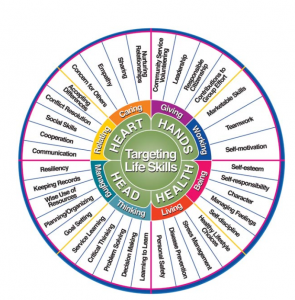
Figure 1. Hendricks, P. (1998) “Developing Youth Curriculum Using the Targeting Life Skills Model”
During the summertime, 4-H typically offers more opportunities for our teen audience since school is not in session as their schedules are more flexible. Because of this, we want to ensure that we are targeting skills that are specific to our teens’ immediate and future wellbeing and success.
In this article, I will discuss why life skills are so important, what 4-H programs already established target, which life skills are most beneficial for our teens and what, when, and how teens can get involved.
WHY DO WE CARE SO MUCH ABOUT LIFE SKILLS?
We know that life skills are abilities learned that help individuals reach their full potential in life. They assist in helping folks successfully handle day-to-day life experiences. We believe they are developed through hands-on learning, activities, and practice.
Life skills are the foundation of 4-H. Utilizing the Targeting Life Skills Wheel (Hendricks, 1998), we connect life skills through 4-H projects, programs, and events to real life experiences based on our Head, Heart, Hands and Health model. By helping youth achieve these life skills, 4-H professionals and volunteers are providing the framework for future academic and employment success, as well as youth thriving and community outreach.
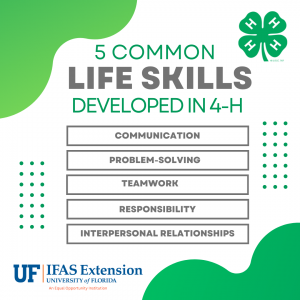
Five essential life skills from the Targeting Life Skills Model commonly developed by participating in 4-H are:
- Communication
- Problem-solving
- Teamwork
- Responsibility
- Interpersonal Relationships
PROJECTS & EVENTS RELATED TO LIFE SKILLS FOR TEENS
Below are just a few 4-H projects and events in Florida 4-H for teens to get involved in to develop and strengthen essential life skills:
- 4-H Tailgating Contest – This program teaches healthy living and the science of grilling seafood, pork, poultry and beef safely outdoors. This program teaches decision making, healthy lifestyle choices, and communication life skills, among others.
- Gator Pit – The Gator Pit is a program open to all teens ages 14-18 in Florida. Youth are taught how to develop entrepreneurial skills through mentorship, competition, and networking to the business community.
- 4-H Legislative – Florida 4-H Legislature provides an opportunity for teens ages 14-18 to experience state government procedures and prepare them for potential leadership in the American democratic process. Youth learn, practice, and defend public policy.
- 4-H University – Florida 4-H University is an opportunity for teens to participate in educational workshops lead by UF faculty, explore potential careers, strengthen interpersonal relationships with peers, and develop critical life skills that will help them become leaders and engaged citizens in their communities.
The Florida 4-H Curriculum Clearinghouse is a list of 4-H resources available, including project curriculum, record books, club resources and other educational publications that meet the standards of Florida 4-H. In this site you can view resources for specific projects. To learn more about 4-H opportunities for teens, please contact your local UF IFAS County Extension Office, or visit http://florida4h.org.
ADDITIONAL SOURCES:
Hendricks, P.A. (1998). Developing Youth Curriculum Using the Targeting Life Skills Model: Incorporating Developmentally Appropriate Learning Opportunities to Assess Impact of Life Skill Development. Iowa State Extension Publication. https://extension.purdue.edu/4-H/about/impact-targeting-life-skills.
Irvine, K. (2019). What are Life Skills? https://blogs.ifas.ufl.edu/nassauco/2019/02/04/what-are-life-skills/
by Niki Crawson | Aug 26, 2022
 Joining a new group of individuals can be nerve-wracking for some that may be shy or intimidated by large groups. Incorporating team-building activities into your 4-H clubs and activities is a great way for 4-H members, new and returning, to form a connection with each other and will help set the tone for that particular group setting and/or event. In this post, we’ll provide tips to bring engaging team-building activities into your 4-H clubs and events. In addition, we will share some of the most popular team-building activities for various age groups that you can use to support your work with 4-H youth.
Joining a new group of individuals can be nerve-wracking for some that may be shy or intimidated by large groups. Incorporating team-building activities into your 4-H clubs and activities is a great way for 4-H members, new and returning, to form a connection with each other and will help set the tone for that particular group setting and/or event. In this post, we’ll provide tips to bring engaging team-building activities into your 4-H clubs and events. In addition, we will share some of the most popular team-building activities for various age groups that you can use to support your work with 4-H youth.
Together Everyone Achieves More
Teambuilding has been proven to have many benefits. Two of the most powerful benefits of team building are increased group morale and individual confidence. Having a new group of individuals learn to work collectively as a team builds rapport and trust. Teambuilding allows individuals to contribute their strengths to the team and also gain additional skills learned from others within the group. This allows for personal growth and development… However, teambuilding does not happen on its own- teams are formed over time with good leadership.
Bruce Tuckman’s Forming-Storming-Norming-Performing model (1965) is arguably the most recognized model for team development, and includes four stages of team development: Forming, Storming, Norming, Performing, and Adjourning:
- Forming: The leader shares goals, but there is no commitment yet; individual roles and responsibilities are unclear. Very leader driven at this point. This stage is essential to help reduce anxiety new members might feel joining a 4-H club or group and will help foster a sense of belonging.
- Storming: Trust hasn’t been established and decisions are difficult to make. Team members try to establish credibility with the group toward the end of this stage.
- Norming: The group is establishing trust—agreement is easier to reach, commitment to goals is evident, and decisions are being made.
- Performing: The group could function on its own without the leader because of the trust, commitment to goals, clarity, and ease of making decisions.
- Adjourning: Recognition and sensitivity to the break-up of the group is important as the team dissolves and members move on to other tasks.
Five Team Building Tips for 4-H Clubs or Groups
Below are five helpful tips for incorporating hands-on activities into your 4-H clubs and events in order to have successful teambuilding interaction:
- The teambuilding process can be longer for some groups than others- it really depends on the needs of the group and how often they meet or interact. If your group meets once a month, it might take longer than if your group is in the same cabin all week at camp.
- Select activities that will address the current needs of your group- if the group is already formed, move on to activities that promote storming.
- If you see a club or activity struggling with a group activity or plan of action, have them take a break and let them participate in a fun
 teambuilding exercise like “Helium Stick“
teambuilding exercise like “Helium Stick“
- Check out our Northwest 4-H Volunteer Google Site for more team-building activities and resources.
- Team building isn’t just for the youth! Consider planning a teambuilding workshop or a night of minute-to-win-it games with your youth vs volunteers or even a 4-H Family night with youth, parents/guardians, and volunteers. This will become a request for an annual event guaranteed!
Five Team Building Activities for “Forming”
The new 4-H year kicks off in just a few days, which means that most 4-H clubs or groups are in the “forming” stage. To help, below are five fun and easy activities you can do with your team to promote “forming.” For more activities and ideas to support all five stages of team building, download our free 4-H Team Building Handbook for a quick reference tool!
- Start your meeting with an easy get-to-know-you icebreaker like “The Superlative Game” in which youth line up based on their birthday, height or age without talking.
- Who’s in the Bag? Ask each person to select an object that represents something about themselves. You can have a variety of objects available for them to select from, or they can bring an item with them. Have each person place their item in the bag, then let each person take turns explaining why the object represents something about themselves.
- Common & Unique- Ask everyone to form a circle. Tell them that you will ask a series of questions, and if the question applies to them, they are to stand inside the circle. Ask questions like “I am the oldest child in my family,” or “I play a sport,” or “I have lived in another state.” This helps members of the group get to know things about other members that they can’t see with their eyes.
- Introductions- Pretend you are hosting a party where no one knows anyone else. Have everyone standing in no particular order. In a party spirit, walk up to one of your “guests” and introduce yourself by name. For example:
- “Hi, I’m Karly. What’s your name? Gabrielle? Hi, Gabrielle, glad to meet you. Come on, there’s someone I want you to meet.” You then take Gabrielle to meet another “guest.”
- “Hi, what’s your name? Paul? Hi, Paul; this is Gabrielle. Gabrielle, this is Paul.” Gabrielle and Paul play it up. They smile, shake hands and say “Glad to meet you.”
- Try to “introduce” everyone in three minutes.
- If you need to meet virtually, don’t skip the team-building activity. Try this activity, “Where Am I?”
By incorporating teambuilding activities into your 4-H delivery, you will be delivering enhanced educational experiential learning in order for our youth to engage in mentally, physically, and socially, fostering the development of essential life skills. To learn more about joining 4-H as a member or volunteer, please contact your local UF IFAS County Extension Office, or visit http://florida4h.org.
SOURCES:
Building A Team Within A 4-H Club. Ohio State University. https://citeseerx.ist.psu.edu/viewdoc/download?doi=10.1.1.230.6481&rep=rep1&type=pdf
Team Building Activity: Helium Stick. Guide, Inc. 2021. https://guideinc.org/2017/08/21/team-building-activity-helium-stick/
The Superlative Game. North Dakota 4-H Recreation Games & Activities. Page 11. https://www.ndsu.edu/fileadmin/4h/ClubMaterials/FJ825_Games___Activities.pdf
Tuckman, B. W. (1965). Developmental sequence in small groups. Psychological Bulletin, 63(6), 384–399.
Why Icebreakers? (2:17) – 4-H Military Partnerships Website – University of Florida/Florida 4-H. https://youtu.be/zWIkGgdEekM
by Niki Crawson | May 20, 2022
Summer is right around the corner. As much as we all love the sunshine feeling on our face and body, too much of a good thing can be harmful! It is always important to remember our family’s well-being, take responsibility for our personal safety, and make healthy decisions, even while having a fun time. Here are some short sun safety reminders to make your summer a fun and enjoyable experience for you and your family members!
SUN SAFETY
Plan Your Day Around the Clock
The sun shares its most harmful rays in the middle of the day so plan this time for indoor use. The sun’s rays are most harmful between the hours of 10 AM and 4 PM so make outdoor time in the early morning or early evening when it is less intense. This also keeps your food at safer temperatures as well so your ice (or you) won’t melt as fast.
Protect Your Body
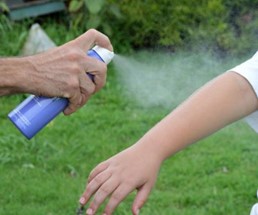
Look for SPF 30 or higher sunscreen.
One of the easiest defenses against the sun is sometimes one of the most forgotten, sunscreen! Be sure to lather up in sunscreen BEFORE you go outside. The American Academy of Dermatology recommends liberally applying a sunscreen that is at least SPF 30 or higher, as these formulas will block UVA and UVB rays. Be sure to apply at least 30 minutes prior to going outside. Once outside, continue to apply sunscreen every two hours or after swimming. Not sure what kind of sunscreen blocks UVA and UVB rays? Look for a sunscreen that is SPF 30 or higher with the ingredients zinc oxide or titanium dioxide as these ingredients will do the job. Remember to coat your ears, neck, tops of feet, etc.
Remember to grab your sunglasses too! Your eyeballs are just as sensitive as your skin so blocking UVA and UBA rays from your eyes are important to. Fashionable sunglasses are great if you are into that but being able to protect your eyes is the goal.
Limit Time

Remember to keep your pets cool too!
Most everyone enjoys getting outside this time of year to soak up some sunshine and enjoy the beautiful day. In fact, it’s true that some amount of sunlight is healthy for your body and mind. However, as we know all too well sometimes, too much exposure can be detrimental and lead to sunburn, heat exhaustion and more. Thus, it is a good idea to find balance by setting a time limit on sun exposure, if possible. If time slips past you because you and your family are having too much fun, set an alarm as a friendly reminder. Make this your “shade time” for a water break, game of cards, or a brief nap. Be sure to always have an umbrella or tent on hand in case no shade is available.
Hydrate
It is very easy to get dehydrated in the summertime. Drink water throughout the day. Don’t wait until you get hot and thirsty. Drink water to maintain your hydration before it is depleted. This will help avoid those nasty summer headaches and tummy aches. Taking your pet with you? Don’t forget Fido’s water bowl too!
4-H PROGRAMMING
UV Bead Activity
Looking for a really cool lesson to teach your children about the risk factors associated with sun exposure and UV rays? Check out this 4-H activity 4-H + Me = Health: Sun Safety from Minnesota Extension Service’s Exploring Your Body, Helper’s Guide. In this activity, children can make their own beaded bracelets that change colors when exposed to UV light. This is a great way for children to understand UV light, cloud coverage, sunscreen SPFs and more!

UV Beads with no sun exposure.
4-H has plenty of educational programming, both outdoors and indoors, to keep your children engaged this summer! From gardening to robots, archery to grilling, 4-H has something for everyone. If you are looking for fun, educational activities during the summer while maintaining a safe environment for your child, please contact your local UF IFAS County Extension Office, or visit http://florida4h.org
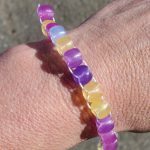
UV Beads with sun exposure.
 When you think of the word “crafting,” you may think of hot glue sticks and pipe cleaners, but crafting also includes practices such as ceramics, woodworking, calligraphy, and leather stamping as well. Using crafting as a teaching tool can encourage youth to apply problem-solving skills, develop new interests, and increase confidence, all while having a fun, hands-on experience. This post covers how crafting can support the 4-H project, what crafting is, and how to prepare craft exhibits for the fair.
When you think of the word “crafting,” you may think of hot glue sticks and pipe cleaners, but crafting also includes practices such as ceramics, woodworking, calligraphy, and leather stamping as well. Using crafting as a teaching tool can encourage youth to apply problem-solving skills, develop new interests, and increase confidence, all while having a fun, hands-on experience. This post covers how crafting can support the 4-H project, what crafting is, and how to prepare craft exhibits for the fair. Here is the information you need to correctly complete your entry tag:
Here is the information you need to correctly complete your entry tag:












